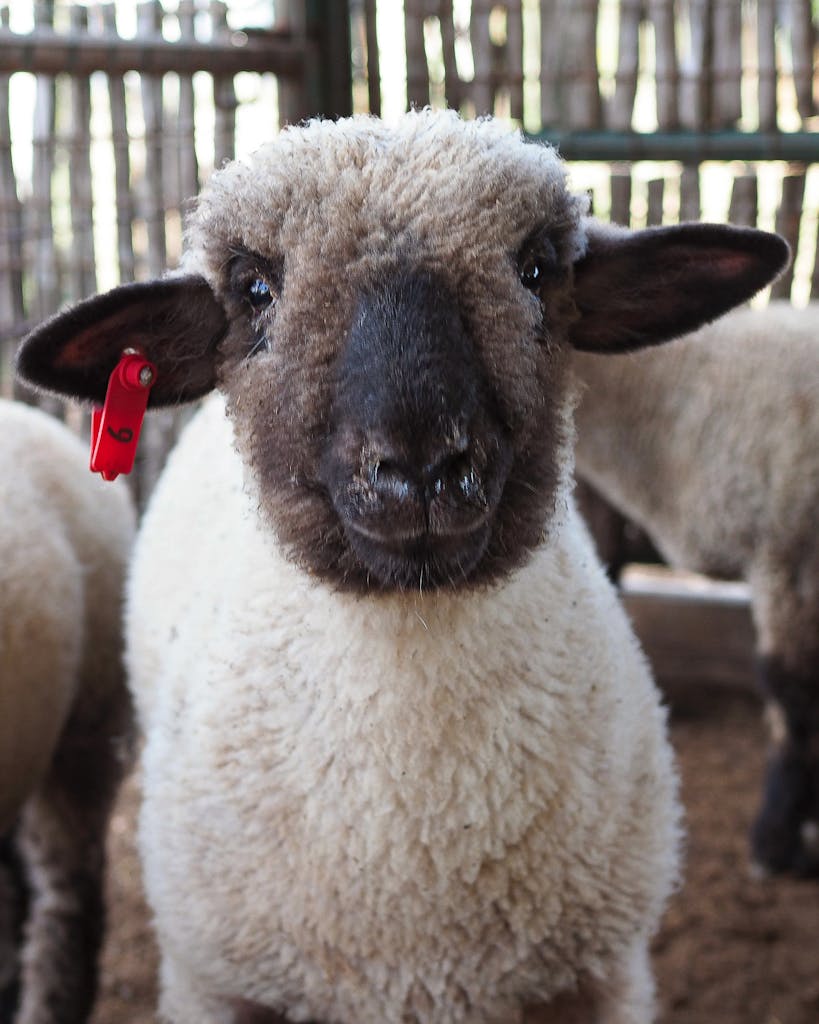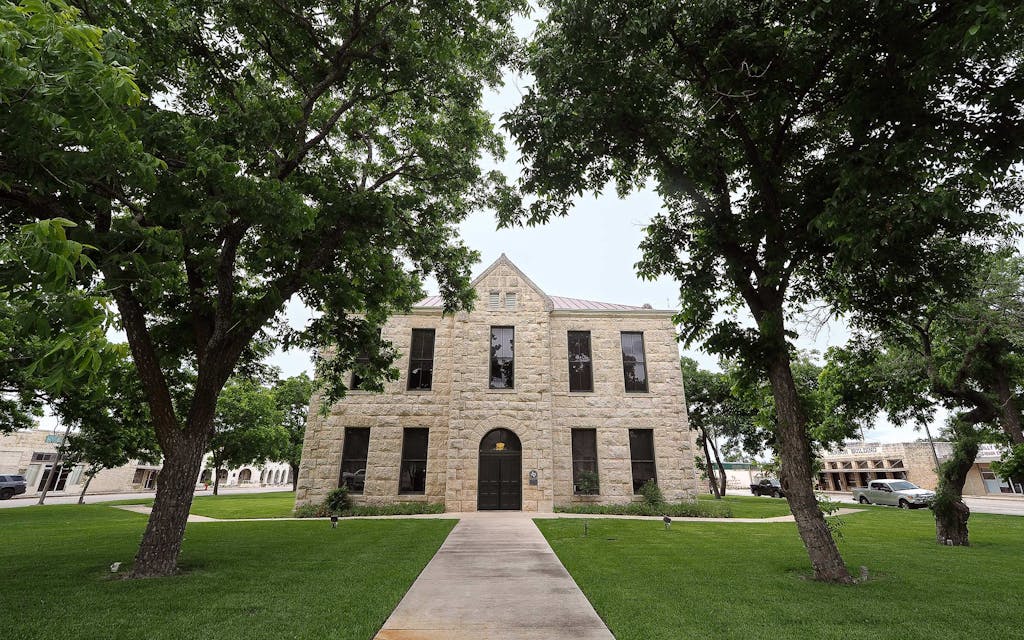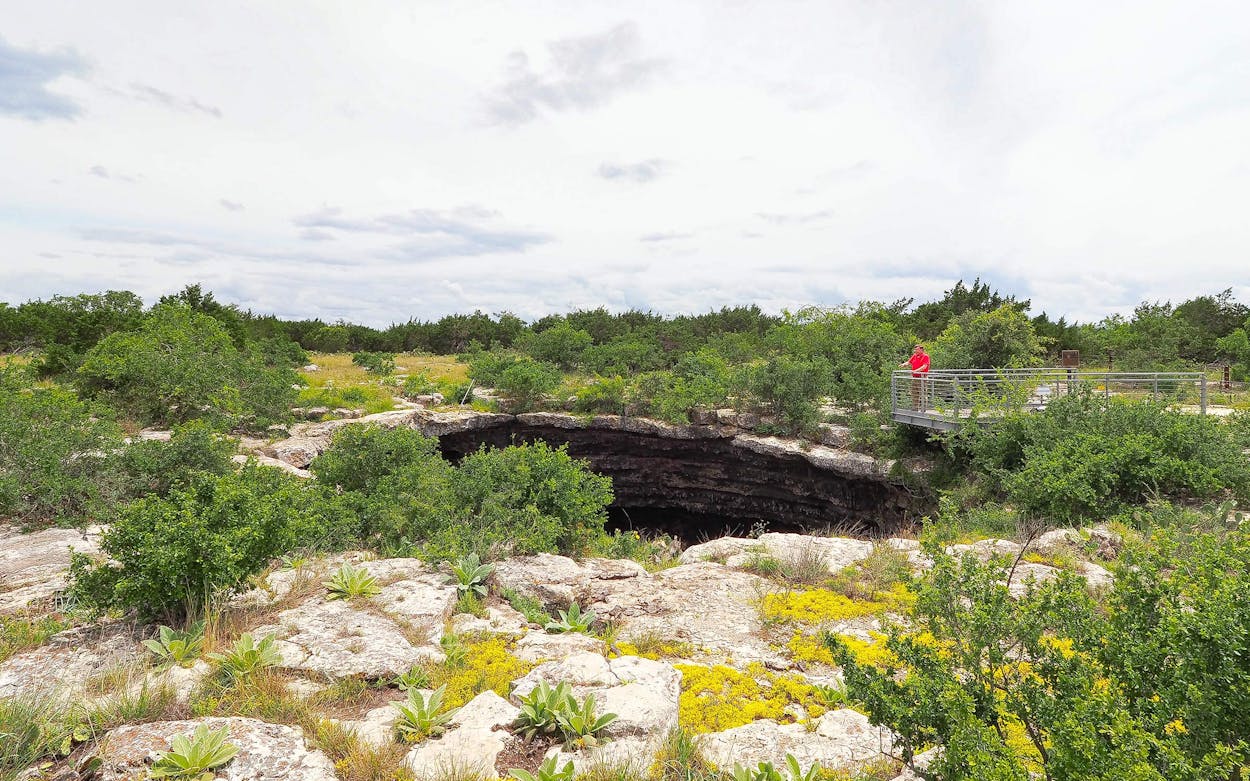I’ve come to the Devil’s Sinkhole to see bats, but on this afternoon in early June, I’m captivated by a gray fox patrolling the edge of the gaping crater. I’m just outside Rocksprings, a town of roughly 1,200 about two hours northwest of San Antonio. From summer through October each year, more than three million Mexican free-tailed bats roost in this cavity, which is so large you could tuck the entire Texas Capitol inside. During the height of the season, they emerge in an impressive tornado of flapping wings almost every night.
For the last few years, though, the bats have arrived a little later in the summer than usual, and tonight’s threat of rain doesn’t help our chances of seeing them, according to Andrew Barnebey, president of the Devil’s Sinkhole Society, which gives tours at the 1,860-acre Devil’s Sinkhole State Natural Area. We’ve come to explore during broad daylight instead. The park is accessible by reservation only; in the daytime, you can take a birding tour or nature walk (fees range from $14 to $20 for adults).
I don’t mind missing the bats this time, since I’ve seen them before. Back in 2012, I watched them stream out of the sinkhole for their nightly forage and then listened alongside biologists the next morning to what sounded like thousands of tiny parachutes opening as they returned. I wondered if one of the furry, plum-size creatures might thwack me in the face as it passed. (Thankfully, bat echolocation works.) Besides, there are plenty of other things to do in Rocksprings, where you won’t find a stoplight but you will find ranches, good food, and a comfortable hotel. I’ve passed through this quiet, welcoming seat of Edwards County a dozen times, on my way to the Devils River and points beyond.
Up to three hundred bats per square foot crowd into some sections of the cave, which spreads out to the size of three football fields below the sinkhole opening. They head out at dusk in the summer—your best bet is to visit between August and October—to gobble up an estimated 28 tons of insects a night. A pair of great horned owls live near the sinkhole opening, too, snatching a few bats out of the air as they exit. “When the bats get going, it’s a jaw-dropping experience,” says Barnebey, a retired high school English and Spanish teacher. “They’re the most wonderful, sweet creatures.”
The sinkhole measures 350 feet deep, but you can’t see all the way down because a 200-foot hill of rubble blocks the view. The cave also holds three lakes, including one that’s 20 feet deep and 80 feet across and is the home to a rare, blind, shrimp-like creature, the Devil’s Sinkhole amphipod. It lives nowhere else in the world. This year marks the park’s fiftieth anniversary as a national natural landmark; a celebration is planned October 1–2.
Since the bats aren’t going to cooperate, I return to Rocksprings, where I meet Stephen Franco, who repairs roads by day and shears sheep and goats by night. Edwards County is rough and rugged, without much grass, but goats thrive here. Rocksprings calls itself the Angora Goat Capital of the World; the region produces about 90 percent of the nation’s mohair, though the industry faded somewhat after a government incentive program ended in 1993. The local newspaper, the Mohair Weekly, still publishes; the American Angora Goat Breeders Association is headquartered here; and a statue of a goat guards the town square.

Tonight, Franco will give haircuts to a herd of lambs at Lazy H Ranch, and I’m tagging along to learn about the process. Franco tells me his father, grandfather, and great-grandfather also sheared, and he began picking up mohair clippings when he was five. By the time he turned eleven he could shear a sheep; he went on to win a state shearing championship. He pulls on boots, grabs his shearer’s handpiece, and settles into a rhythm. These lambs will be sold as show animals, and a close cut allows buyers to check their conformation. “People say you’re crazy for doing this—it’s hard labor,” he says as he flips over a lamb, runs the handpiece over its belly, and peels away thick strips of wool. “But I like to have a little extra money in my pocket.”
Later, I check in at the Historic Rocksprings Hotel, built in 1916 and run by Houston native Debra Wolcott. She and her husband bought the building thirteen years ago and have renovated it since. Rooms are basic but comfortable, and guests can peruse Wolcott’s collections of bells, teapots, and—across the street in the old bank building—dollhouses. A stuffed bobcat grins up from atop a table in the common area.
“I meet interesting people from all over,” Wolcott says. “I enjoy welcoming them here. This place is still very authentic. I love Fredericksburg [the tourist mecca about 98 miles east], but this area is still ranching, rural, hunting, outdoors, and nature, and people who live here work very hard.”
Hunters looking for white-tailed deer, motorcyclists who come to ride the Twisted Sisters (curvy Ranch Roads 335, 336, and 337), tourists like me—and, since the pandemic, an increasing number of city dwellers looking for vacation properties—make up most of her clientele. “It’s a land rush,” Wolcott says.
She hands me a book about the mile-wide tornado that swept through Rocksprings on April 12, 1927, demolishing all but 12 of the community’s 400 buildings, collapsing homes, twisting windmills, and killing at least 76 people, some never identified. Legends abound: a teenager in a bathtub swept from her home, a church bell carried for miles by the storm, the water tower mangled and overturned, its contents drowning victims below. The courthouse, built in 1891, served as a morgue, and Wolcott’s hotel doubled as a hospital. The town gets its name from a seep of water that once emerged from beneath a rock, but it has since dried up. The population topped out at about 1,400 in the fifties, at the peak of the wool and mohair business.

It’s pouring rain when I pull up to Priour Varga Wool & Mohair the next morning. Inside the waiting room at the warehouse, where ranchers bring wool and mohair for sorting and selling, a couple of them are sipping coffee and lamenting the trend of subdividing area ranches into smaller parcels used for deer hunting. I’m here to watch a ritual that’s taken place for more than sixty years: mohair grading. Manager Steve Haynes leads me inside the cavernous warehouse, where Ralph Ramos stands at a table, sifting with his bare hands through a pile of what looks like clumpy, gray cotton candy, packing it into wooden boxes the size of chest freezers.
“Your hands tell you everything,” Haynes says, explaining that Ramos is sorting the mohair according to its fineness. Buyers travel from as far as South Africa and England to purchase the fiber, shipping it overseas for processing before it’s made into products like socks, sweaters, and carpets. “This way of life is an old way of life, and we’ve been doing it a long time,” Haynes says.
I’ve got a few minutes to burn, so I take the locals’ advice and wander into the Rocksprings Home and Ranch Supply across the street, where thousands of arrowheads and spear points are framed and kept behind a hog wire cage along one wall. The dusty, dimly lit room is worth a stop—thousands of artifacts are on display, including a supposedly human bone with a point embedded in it. There’s also a John Deere wagon from the 1800s that’s appeared in seventeen movies and TV programs, including Lonesome Dove, according to Dennis Mitchell, who was watching the shop.
Then it’s time for lunch. The longest-running restaurant in Rocksprings is the King Burger, known for its onion-topped cheese enchiladas and homemade salsa. Three blocks west, the Jail House Grill & Bar serves tasty food with tasteless names like the Deathrow Ribeye and the Electric Chair Burger. For this meal, though, I’m going to the Lotus Thai Cafe, where chef and owner Aisika Davidson, who grew up in Nakhon Si Thammarat, Thailand, has won a loyal fan base for her homemade curries, noodles, and stir-fries. She opened the restaurant six years ago after moving to Rocksprings with her husband. “I didn’t know what to do. But I know how to cook,” she tells me when I lean my head into the kitchen after a standout meal of pad thai. “I try to keep everything real Thai.”
I wrap up my tour of Rocksprings with a trip to meet Jake Shanklin, a former professional polo player who now trains horses, goats, and cattle. He and his two sons live on the old family ranch northwest of town. “I’ve got an affliction, and it’s horses,” Shanklin tells me, leaning against his granddad’s old wooden chuck box in the tack room as rain clatters on the roof. He planned to brand calves today, but the storm has stalled those plans. He tells me about his grandparents and parents, who once worked this land, raising cattle and sheep. It’s hard but satisfying work. “We don’t know anything else, don’t care to,” Shanklin says.
He left Rocksprings for twenty years to travel the world as a professional polo player, but knew he had to come back to this place, where his history runs deep. “It’s a place you wanted to get away from and a place you wanted to get back to too.” I’m not from here, but I understand. Rocksprings is as Texas as a town comes, unapologetically tough and gritty. But it’s friendly and welcoming, too, with plenty of fascinating history and prickly beauty.






